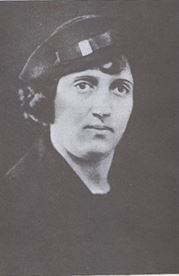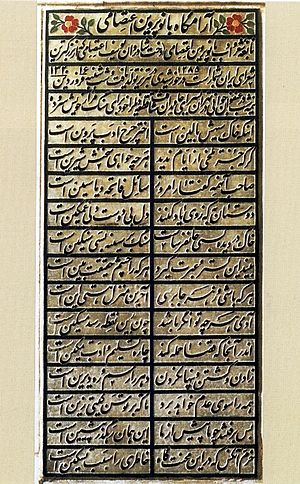Parvin E'tesami facts for kids
Quick facts for kids
Parvin E'tesami
|
|
|---|---|
| پروین اعتصامی | |
 |
|
| Born |
Rakhshandeh E'tesami
1907 |
| Died | April 4, 1941 (aged 33–34) Qom, Pahlavi Iran
|
| Alma mater | Iran Bethel School |
| Occupation | Poet |
| Spouse(s) | Fazlollah E'tesami (1934–1935, separation) |
| Parent(s) |
|
| Relatives | Abolhassan E'tesami (uncle) |
Parvin E'tesami (born Rakhshandeh E'tesami; 1907 – April 4, 1941) was a famous Iranian poet from the 20th century. She wrote many beautiful poems in the Persian language.
Contents
Life Story of Parvin E'tesami
Parvin E'tesami was born in 1907 in Tabriz, a city in Iran. Her father was Mirza Yussef E'tesami Ashtiani, who was a well-known scholar. Her family moved to Tehran, the capital city, when she was young.
Parvin grew up in a home filled with books and learning. Her father taught her a lot about Arabic and classical Persian literature. She started writing poems when she was only 8 years old!
Her Education and Early Career
Parvin went to the Iran Bethel School in Tehran. This was an American high school especially for girls. She finished school in 1924. After graduating, she even taught at the same school for a while.
For her graduation, Parvin wrote a special poem called A Twig of a Wish. This poem talked about the challenges Iranian women faced. It also highlighted how important it was for girls to get an education.
In 1926, she was asked to become a tutor for the queen of Iran. However, Parvin chose to refuse this offer.
Marriage and Later Years
In 1934, Parvin married a cousin of her father, Fazlollah E'tesami. They moved to the city of Kermanshah. But their marriage was very short, lasting only ten weeks. They separated because they had different interests and personalities. Parvin then returned to Tehran.
Parvin was a member of a group called the Kanoun-e-Banovan. This group supported women's rights and education. She also supported a reform that was against the compulsory wearing of the hijab (veil).
In 1936, the Shah of Iran, Reza Shah Pahlavi, offered her an important award. It was called the third-degree Iran Medal of Art and Culture. But Parvin politely declined the award.
From 1938 to 1939, she worked for a few months at a library in Tehran. This library was part of a university.
Sadly, her father passed away in 1938. Parvin herself died just three years later, in 1941. She was only 34 years old. She died from Typhoid fever. Parvin was buried next to her father in Qom, near a famous shrine.
In 2006, Parvin E'tesami's house became a national heritage site in Iran. This means it's an important historical place.
Parvin E'tesami's Poetry

Parvin E'tesami showed her talent for poetry when she was very young. Her father encouraged her to write. She even turned some stories her father translated from Western books into poems.
Her Published Works
Some of her first poems were published in a Persian magazine called Bahar in the early 1920s. She was still a teenager then.
Her first book of poetry, called a Diwan, came out in 1935. It had 156 poems. A famous poet and scholar, Mohammad-Taqi Bahar, wrote an introduction for her book.
A second edition of her book was published shortly after she died in 1941. This edition was put together by her brother. It included 209 different poems. These poems were written in various classical Persian styles.
Style and Themes
Even though she lived a short life, Parvin became very famous in Iran. Her poetry followed the traditional Persian style. She didn't really follow the newer trends in poetry at the time.
Many of her poems are like lessons or philosophical thoughts. She also wrote many poems about nature.
One of her most famous poems is Safar-e ashk, which means "Journey of a Tear." Experts say it's one of the best poems ever written in Persian.
A big part of Parvin's book of poems is made up of monazara poems. These are like debates or conversations. She wrote about 65 poems in this style. She also wrote many fables and allegories, which are stories with a hidden meaning.
In these poems, Parvin would have different characters talk to each other. These characters could be people from different backgrounds, animals, birds, flowers, or even everyday objects. Through these conversations, she showed problems in society. She also shared her ideas about life, death, social justice, good behavior, education, and how important knowledge is.
Parvin E'tesami started writing poetry when she was young. Her work mixed old traditions with new ideas. While her style was classical, her poems often explored modern themes.
See also
 In Spanish: Parvin E'tesami para niños
In Spanish: Parvin E'tesami para niños
- Forough Farrokhzad
- Simin Behbahani
- Mina Assadi


